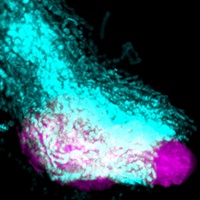'Chase and run' cell movement mechanism explains metastasis
18 Jun 2013
A mechanism that cells use to group together and move around the body - called 'chase and run' - has been described for the first time by scientists at the University College of London.
 |
| Time projection of a time-lapse movie showing coordinated migration of Neural crest cells (blue) and placodes (magenta). Credit: Theveneau and Mayor |
Published in Nature Cell Biology, the new study focuses on the process that occurs when cancer cells interact with healthy cells in order to migrate around the body during metastasis.
Scientists know that cancer cells recruit healthy cells and use them to travel long distances, but how this process takes place and how it could be controlled to design new therapies against cancer remains unknown.
Now, using embryonic cells called 'neural crest cells' (which are similar to cancer cells in term of their invasive behaviour) and placode cells which are the precursors for cranial nerves (the equivalent to healthy cells) researchers at UCL have started to unravel this process.
They have found that when neural crest cells are put next to placode cells they undergo a dramatic transformation and start 'chasing' the placode cells.
At the same time placode cells exhibite 'escape' behaviour when contacted by neural crest cells. The chasing behavior depends on the production of small chemical molecules by the placode cells that attracts neural crest cells toward them.
The authors of the study are confident that the process whereby cancer cells attached to healthy cells in order to migrate around the body is comparable. Healthy cells of the body try to escape from tumor cells, but are followed by malignant cells because the healthy cells produce an attractant for the cancer cells.
Dr Roberto Mayor, UCL Department of Cell and Developmental Biology and lead author of the research, says, "We use the analogy of the donkey and the carrot to explain this behaviour: the donkey follows the carrot, but the carrot moves away when approached by the donkey. Similarly the neural crest cells follow the placode cells, but placode cells move away when touched by neural crest cells."
"The findings suggest an alternative way in which cancer treatments might work in the future if therapies can be targeted at the process of interaction between malignant and healthy cells to stop cancer cells from spreading and causing secondary tumours."
He added: "Most cancer deaths are not due to the formation of the primary tumor, instead people die from secondary tumors originating from the first malignant cells, which are able to travel and colonize vital organs of the body such as the lungs or the brain."
The work was funded by the Medical Research Council and the Wellcome Trust.













.jpg)






.jpg)









